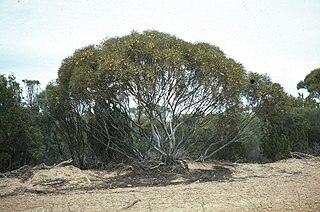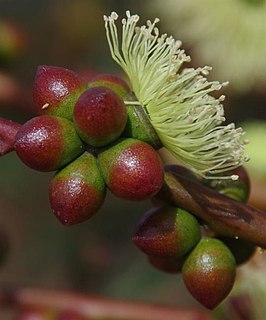
Eucalyptus comitae-vallis, commonly known as Comet Vale mallee, is a mallee that is endemic to the south-west of Western Australia. It has rough, flaky to ribbony bark on the trunk and larger branches, smooth withish bark above, linear to narrow lance-shaped adult leaves, flower buds in groups of seven to eleven, white flowers and barrel-shaped, conical or cup-shaped fruit.
Eucalyptus blaxellii, commonly known as the Howatharra mallee, is a mallee that is endemic to Western Australia. It has smooth bark, linear to narrow lance-shaped adult leaves, flower buds arranged in groups of seven, white flowers and cup-shaped to conical fruit.

Eucalyptus capillosa, commonly known as wheatbelt wandoo, or mallee wandoo, is a species of tree or mallee that is endemic to Western Australia. It has smooth, grey bark, lance-shaped to elliptic adult leaves, spindle-shaped flower buds in groups of nine to thirteen, white flowers and barrel-shaped to cylindrical fruit.

Eucalyptus deflexa, commonly known as Lake King mallee, is a species of mallee that is endemic to Western Australia. It has smooth grey to whitish bark, linear to elliptic or curved adult leaves, pendulous flower buds arranged in groups of seven, cream-coloured or pink flowers and pendulous barrel-shaped fruit.

Eucalyptus effusa, commonly known as rough-barked gimlet, is a species of mallee or small tree that is endemic to Western Australia. It has thin, rough bark on the base of the trunk, smooth bark above, linear to narrow lance-shaped adult leaves, flower buds arranged in groups of seven, white flowers and cup-shaped to conical fruit.
Eucalyptus exigua is a species of mallee that is endemic to Western Australia. It has smooth, whitish bark, linear to narrow lance-shaped adult leaves, flower buds in groups of between seven and eleven, white flowers and short barrel-shaped to conical fruit.

Eucalyptus latens, commonly known as narrow-leaved red mallee, is a species of mallee that is endemic to the south-west of Western Australia. It has smooth grey and coppery bark, linear to narrow lance-shaped adult leaves, flower buds in groups of seven to eleven or more, creamy white flowers and small barrel-shaped to shortened spherical fruit.
Eucalyptus misella is a species of mallee that is endemic to a small area of Western Australia. It has smooth, greyish bark, narrow oblong to narrow elliptical leaves, flower buds in groups of between seven and eleven, white flowers and flattened spherical fruit.

Eucalyptus phaenophylla, also known as common southern mallee, is a species of mallee that is endemic to Western Australia. It has smooth bark, linear to narrow lance-shaped or narrow elliptical adult leaves, flower buds in groups of up to thirteen, pale lemon-coloured flowers and barrel-shaped, cylindrical or conical fruit.
Eucalyptus planipes is a species of mallee that is endemic to Western Australia. It has smooth bark, lance-shaped adult leaves, flower buds in groups of three and conical fruit.
Eucalyptus quaerenda is a species of mallee that is endemic to the southwest of Western Australia. It is an often rounded mallee with foliage reaching the ground and has smooth bark, linear adult leaves, flower buds in groups of seven, creamy white flowers and shallow, cup-shaped to flattened spherical fruit.
Eucalyptus ravida is a species of small mallet that is endemic to Western Australia. It has smooth, shiny bark, lance-shaped adult leaves, flower buds in groups of seven, white flowers and conical to hemispherical fruit.

Eucalyptus sporadica, commonly known as the Burngup mallee, is a species of mallee that is endemic to the southwest of Western Australia. It has smooth bark, lance-shaped adult leaves, flower buds in groups of seven, yellowish flowers and down-turned, conical to cylindrical fruit.
Eucalyptus suggrandis is a species of mallee that is endemic to the southwest of Western Australia. It has smooth, shiny bark, linear to elliptical leaves, flower buds in groups of three or seven, creamy white flowers and cup-shaped to conical fruit.
Eucalyptus tenera, commonly known as the glazed mallee or sand mallee, is a species of mallee that is endemic to Western Australia. It has smooth bark, narrow lance-shaped to elliptical leaves, flower buds in groups of seven to eleven, lemon yellow flowers and cup-shaped to barrel-shaped fruit.
Eucalyptus tephroclada is a species of mallee that is endemic to the southwest of Western Australia. It has smooth bark, lance-shaped adult leaves, flower buds in pendent groups of nine to thirteen, pale lemon yellow flowers and barrel-shaped to cup-shaped fruit.
Eucalyptus vegrandis, commonly known as the Ongerup mallee, is a species of mallee that is endemic to the south-west of Western Australia. It has smooth bark, linear to lance-shaped adult leaves, flower buds in groups of seven, creamy white flowers and cup-shaped or conical fruit.
Eucalyptus delicata is a species of tree that is endemic to Western Australia. It has rough, fibrous to scaly bark on the trunk, smooth white to greyish bark above, linear to narrow lance-shaped adult leaves, flower buds in groups of between seven and eleven, creamy white flowers and more or less spherical to barrel-shaped fruit.

Eucalyptus terebra, commonly known as Balladonia gimlet, is a species of gimlet that is endemic to Western Australia. It has satiny or glossy bark on its fluted trunk, linear to narrow lance-shaped adult leaves, flower buds in groups of seven, yellowish flowers and conical to hemispherical fruit. It is one of the seven species of gimlet.
Eucalyptus orthostemon is a species of mallee that is endemic to the south-west of Western Australia. It has smooth coppery and greyish bark, linear adult leaves, oval to spindle-shaped buds in groups of seven, creamy white flowers and conical to cup-shaped fruit.








